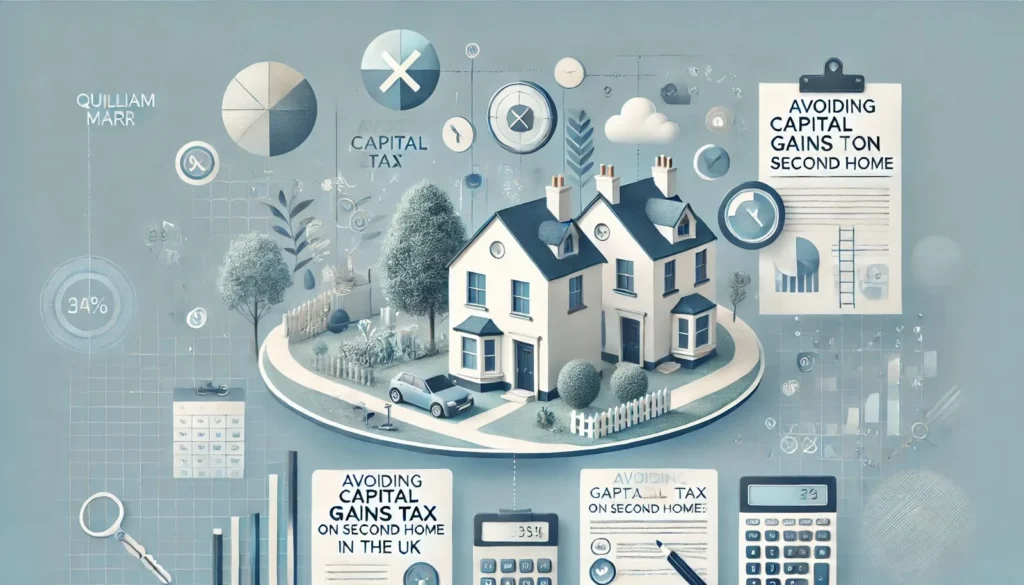Owning a second home in the UK can be a valuable investment, but it comes with financial responsibilities, including capital gains tax. Many homeowners wonder how to reduce or legally avoid paying this tax when selling a second property. Understanding how to avoid capital gains tax on second homes UK requires careful planning, knowledge of current rules, and awareness of reliefs that can significantly lower your tax liability.
Capital gains tax is applied to the profit you make when selling a property that is not your main residence. The amount owed depends on your income level, the gain realised, and any exemptions or allowances you can claim. Learning how to avoid capital gains tax on second homes UK ensures you keep more of your investment while complying with HMRC regulations and avoiding potential penalties.
What is Capital Gains Tax on Second Homes in the UK
Capital gains tax is the amount you pay on the increase in value of your property when sold. Second homes are fully liable for this tax, unlike your main residence, which may benefit from Private Residence Relief. Understanding how to avoid capital gains tax on second homes UK starts with knowing what constitutes a gain and how HMRC calculates taxable profits.
In the UK, capital gains tax rates for residential property are 18% for basic-rate taxpayers and 28% for higher-rate taxpayers. The tax applies to gains above the annual exempt amount, which is reviewed each year. Knowing the rates, exemptions, and your potential liability is essential for planning a property sale in a tax-efficient way.
How Private Residence Relief Can Reduce Capital Gains Tax
Private Residence Relief, often referred to as PRR, can reduce the amount of capital gains tax you owe if the property has been your main home at some point. Even if you move to a new property, PRR may still apply to part of the gain. Learning how to avoid capital gains tax on second homes UK involves understanding the nuances of this relief and when it can be claimed.
Eligibility for PRR depends on the period you lived in the property and whether it was your only or main residence during that time. Homeowners can also nominate which property qualifies as their main residence if they own multiple homes. Properly applying PRR can reduce your capital gains significantly, making it a critical tool in tax planning.
Using Annual Allowances and Offsetting Losses
One of the most straightforward ways to reduce capital gains tax is to make use of your annual CGT allowance. Each individual has a tax-free gain threshold each year, and any profit below this limit is exempt from tax. Knowing how to avoid capital gains tax on second homes UK means planning the sale so that you maximise this allowance.
Another method is to offset any capital losses from other investments against your gains. For example, if you have sold other properties or shares at a loss, these can be used to reduce the taxable gain on your second home. Proper record-keeping and planning allow homeowners to take full advantage of these strategies legally.
Gifting Property and Family Transfers
Gifting a second home to a spouse or civil partner is another legal strategy to manage capital gains tax. Transfers between spouses are generally exempt from CGT at the time of transfer, and the tax liability only arises when the recipient decides to sell the property. Understanding how to avoid capital gains tax on second homes UK often involves careful consideration of family arrangements and transfers.
Transferring property to family members or trusts can also provide tax planning opportunities, but it is essential to seek professional advice. Incorrectly structured transfers may result in unintended CGT liabilities. Legal planning ensures that gains can be minimised without breaching HMRC regulations, giving homeowners peace of mind.
Claiming Allowable Expenses and Lettings Relief
You can reduce your taxable gain by claiming allowable expenses incurred during the purchase and sale of the property. These can include solicitor fees, estate agent costs, and expenses for improvements. Learning how to avoid capital gains tax on second homes UK means ensuring that all legitimate costs are properly documented and claimed.
For landlords, lettings relief can also apply in some cases, though the rules have changed in recent years. Previously, relief was available for properties that had been rented out while also being a main residence. Keeping up-to-date with current rules allows property owners to take advantage of any reductions legally available.
Timing Your Sale to Reduce Tax
The timing of your property sale can influence the capital gains tax you pay. Selling across multiple tax years may help spread the gain and make use of multiple annual allowances. Knowing how to avoid capital gains tax on second homes UK involves strategic planning regarding the sale date and your overall financial situation.
Market conditions can also affect timing. Selling when property values are high may maximise profit, but careful planning to offset the gain against allowances and reliefs can reduce the tax burden. Homeowners who plan ahead are better positioned to balance profit and tax efficiency.
Avoiding Common Mistakes
Many homeowners make errors that increase their CGT liability. Failing to claim all allowable expenses, misunderstanding relief eligibility, or missing reporting deadlines can lead to overpayment. Knowing how to avoid capital gains tax on second homes UK includes staying organised and consulting experts when necessary.
Incorrectly nominating your main residence or ignoring PRR rules is another frequent mistake. Keeping detailed records of property use, costs, and dates is essential for accurate reporting. Avoiding these common pitfalls ensures a smoother sale and minimises the risk of HMRC challenges.
Calculating Capital Gains Tax Accurately
To calculate CGT, subtract the purchase price and allowable costs from the sale price to determine your gain. Then apply any reliefs, annual allowances, and CGT rates. Understanding how to avoid capital gains tax on second homes UK requires familiarity with this calculation and awareness of tools and calculators available online.
Professional advice is invaluable for complex scenarios, such as joint ownership or inherited property. Accountants can help ensure you apply all available reliefs and allowances accurately, minimising your tax liability. Accurate calculations help avoid surprises and give clarity when planning property sales.
Conclusion
Learning how to avoid capital gains tax on second homes UK involves a combination of knowledge, planning, and legal strategies. Using allowances, PRR, gifting, allowable expenses, and careful timing can significantly reduce your taxable gain. Staying informed and seeking professional guidance ensures you comply with UK tax law while keeping more of your investment profit.
You may also read: When Do Estate Agents Take Property Off Market? Complete UK Guide



